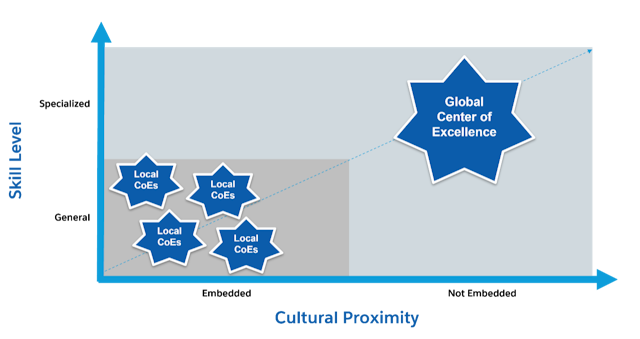Your global ‘center of excellence’ could actually be sabotaging you
Without appropriate cultural relevance, data analysis and distributed resources and knowledge, centers of excellence can undermine global success, writes Salesforce’s Martin Kihn as part of The Drum’s Globalization Deep Dive.

/ Leon Seibert
Many of us remember where we were during the great chopstick scandal of 2018, when a storied luxury fashion maison launched three highly-produced videos on YouTube in China to support an upcoming show.
In them, models tried to eat traditional Italian food like cannoli and pizza using chopsticks, with predictable results: a hot mess for both the utensils and the brand, which faced a chorus of complaints from Chinese consumers on Weibo and other platforms, claiming cultural tone-deafness.
The brand quickly pulled the videos, canceled the show and has since lost share in the Chinese market. Part of the problem was a lack of localization in global brand messaging – or what one study of social marketing fails politely called “inadequate research.” The brand had a world-class marketing team, but it was back in Milan, the company’s de facto ‘center of excellence’ (CoE).
During a time of cultural sensitivity, global marketers must balance the imperative to build out such centers with a growing need for in-market nuance. There are new forces facing global marketers that call into question the conventional rush to build centers of excellence across almost every functional discipline.
It turns out, excellence may increasingly be found at the edge – not the center.
Advertisement
Four horsemen of the CoE-pocalypse
There is much logic and some evidence that CoEs can add value. Firms such as Gartner have long championed CoEs for marketing functions such as analytics and data science. They generally define a CoE as a discrete cadre of coordinated professionals with specific, uncommon expertise, who cross-reference ideas, disseminate practices and templates and function as a skilled resources for dispersed global operations.
So compelling is the impulse to the CoE model that it is difficult to find any doubters. Consultancies such as McKinsey routinely recommend establishing a CoE for advanced functions. For example, a recent McKinsey report on automation says: “A center of excellence is vital both as a source of expertise and to define priorities.” Meanwhile, the US Army has at least 15 CoEs for functions from missile defense to human resources.
Advertisement
Global marketers have taken the advice and adopted CoEs. A Gartner survey indicated that two-thirds of enterprise marketers already had an analytics CoE five years ago – yet this year, 26% of CMOs identified analytics as an ongoing capability gap. The same research revealed global marketers had a lot of swagger about their ’operational excellence’ (only 15% cited as a gap), due in part to CoEs.
Yet as the chopstick incident implies, not all wisdom can be centralized. And there are a number of rising forces that point toward the need for global marketers to question the march toward CoEs.
The four horsemen of the CoE-pocalypse are:
Cultural relevance: Local consumers require local nuance – and will take to social media if it’s missing.
Data bias: AI and machine learning models can inherit bias from data collection and processing methods, both of which can have a cultural dimension that is only now being recognized.
Knowledge resources: Many formerly ‘specialized’ disciplines – including reporting and campaign automation – are more common, with widespread learning resources.
Distributed workforce: More dispersed and hybrid employment models undermine some of the CoEs’ neo-Xerox Park ‘skunkworks’ premise.
Suggested newsletters for you
To CoE or not to CoE?
How is a marketer to assess whether or not a CoE makes sense for a particular situation? As an ex-consultant, I’d be surprised if I didn’t propose a solution in the form of 2x2 framework.
CoEs are supposed to support: (1) availability of specialized skills; and (2) processes that can be run globally rather than locally. So by implication the axes of our 2x2 are:
Skill level: specialized v unspecialized
How hard are the skills to find in most global markets? If they’re rare and uncommon, or less rare in some regions than others, a CoE may be in order. As marketing teams get more sophisticated over time, fewer skills may fall into this area. (According to Gartner, the hardest marketing skills to find in the current environment are data and analytics, customer experience management and marketing technology; the easiest is social marketing).
Cultural proximity: embedded v not embedded in local culture
Is the function something that requires an awareness of how actual human beings talk, think and work in a specific context or not?
Another way to evaluate this requirement is in symbolic terms: How much does the function use global symbols, such as numbers, versus more culturally loaded symbols like words and images? If it’s mostly about numbers, a CoE could work – and if not, it may be time to reevaluate.

So the CoE is most useful for marketing challenges related to data modeling and predictions, such as next-best-action and -experience – and for data operations and automation projects that can be standardized across regions. It is less useful for developing creative artifacts for specific regions and building media plans.
Let’s apply the framework to our original example. We see the capabilities required are video production and creative development, skills that are both locally available and deeply embedded in the culture – so, not amenable to the CoE treatment. On the other hand, were that same brand to implement a marketing automation system, it would be entirely reasonable to spin up a CoE for that.
As we go forth into our new world of global marketing, we should take care to discriminate non-human processes from very human communications and recognize that both standardization and globalization have their limits.
Martin Kihn is senior vice-president of strategy at Salesforce Marketing Cloud. For more on what marketers and their partners need to do to succeed on a global level, check out The Drum’s Globalization Deep Dive.
